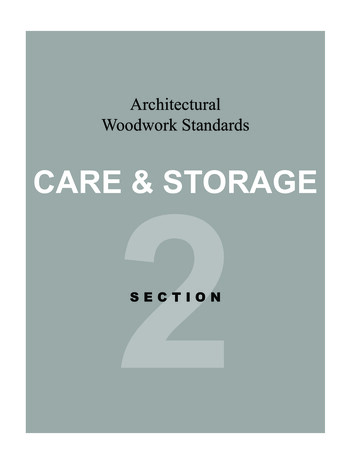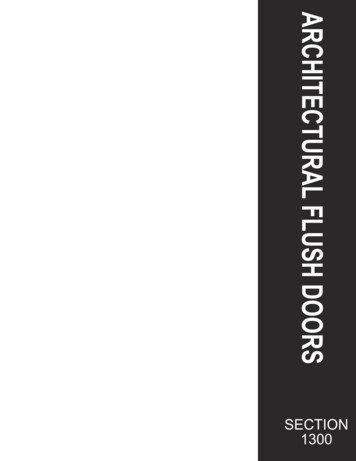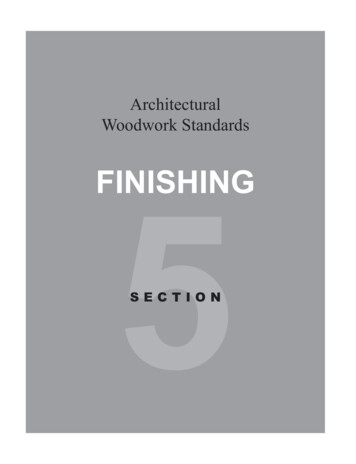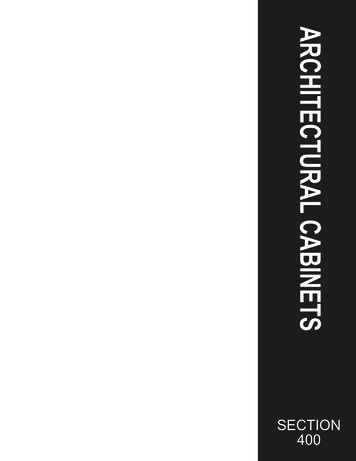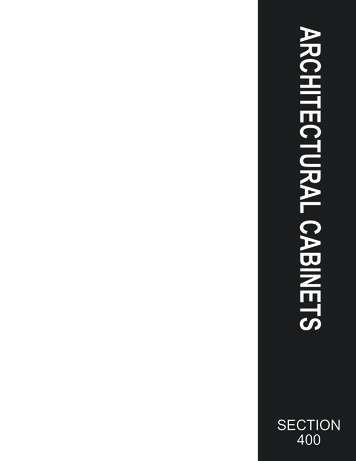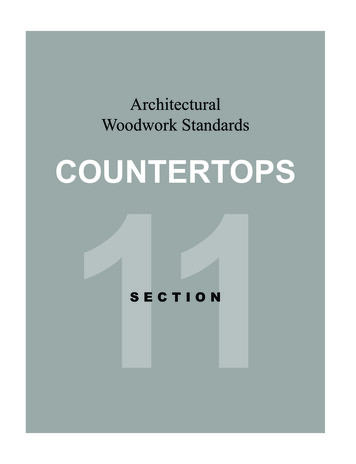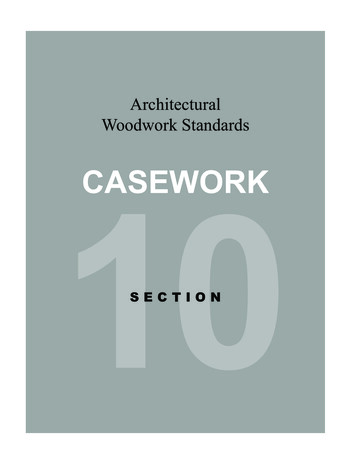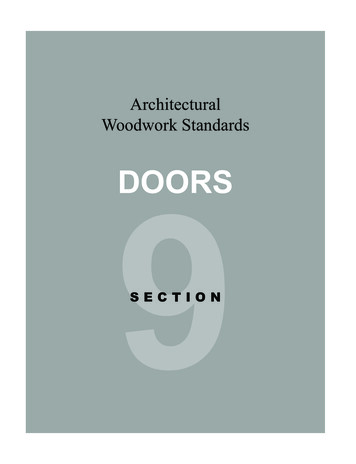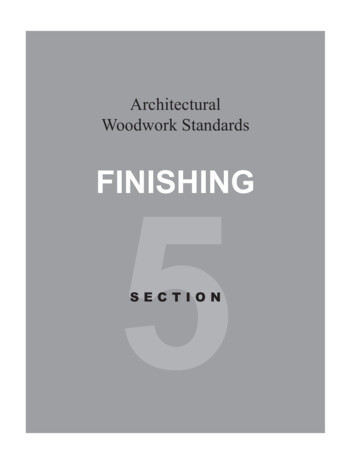
Transcription
ArchitecturalWoodwork Standards5finishingsection
SECTION 5FinishingIntroductory InformationIntroduction. 1105table of contentsCompliance RequirementsGENERALPurpose. 110Basic Considerations. 117Factory / Field Finishing. 110Grade. 117Important Considerations. 110Classifications. 117Specifications. 110Compliance Requirements. 117Varying Costs. 110Contract Documents. 117Intermixing Systems. 110Aesthetic Compliance. 117Application. 110Listing. 117Curing. 110Factory or Field. 117Prefinished Wood Panels. 110Industry Practices. 117Panel Products. 111Door Manufacturer. 117Barber Pole. 111Finisher of Wood Components. 117Grain. 111Finishing Systems. 117Open. 111PRODUCTClosed. 111Scope. 118Color and Grain Enhancement. 111Typical Inclusions. 118Color Match and Consistency. 111Typical Exclusions. 118Sheen. 111Default Stipulation. 118Transparent. 111Rules. 118Blotchy Appearance. 111Errata. 118Techniques to Consider. 111Basic Rules. 118Sanding. 111Finisher. 118Wash Coat. 112Samples. 118Blue Stain. 112Aesthetic Rules. 119Fire Retardant Treated Wood and Coatings. 112Overall Appearance. 119AWS Finishing Systems. 112Application Techniques. 119General Performance Characteristics Table. 113Incompatibility. 119Specific Performance Characteristics Table. 114Paneling. 119Usage and Performance Score Comparison Table . 115Trim and Frames. 119Specify Requirements For . 116Doors. 119Recommendations . 116Casework. 119Defects and Workmanship. 119First Class Workmanship.120108 Architectural Woodwork Standards 2014 AWI AWMAC WI 2nd Edition, October 1, 2014
SECTION 5Finishingtable of contentsCompliance RequirementsPRODUCT(continued)(continued)Material Rules.120Priming and Sealing.120Flow Properties.120TESTSBasic Considerations.125Visual Testing.125Testing for Consistency.125Sheen Testing.125Chemical Resistance.120Application Rules.121Sanding.121Factory Priming.121Ventilation.121Over istency.121Film Thickness.121Filler.121Thoroughly Dry.121Sapwood.121Staining.121Generic Coating Schedule.121System Coating Schedule.122System 1.122System 2.122System 3.122System 4.122System 5.122System 6.123System 7.123System 8.123System 9.123System 10.123System 11.124System 12.124System 13.124After Finishing.124Touch up.124 2014 AWI AWMAC WI 2nd Edition, October 1, 2014Architectural Woodwork Standards109
SECTION 5FinishingINTRODUCTIONSection 5 pertains to shop and field finishing ofarchitectural woodwork. Thirteen finishing systemsare outlined with application rules and methods oftesting.5Quality assurance can be achieved by adherenceto the AWS and will provide the owner a qualityproduct at competitive pricing. Use of a qualifiedSponsor Member firm to provide your woodworkwill help ensure the manufacturer’s understandingof the quality level required. Illustrations in thisSection are not intended to be all inclusive, otherengineered solutions may be acceptable. In theabsence of specifications; methods of fabricationare the manufacturer’s choice. The designprofessional, by specifying compliance to the AWSincreases the probability of receiving the productquality expected.PURPOSEThe purpose of finishing woodworking is twofold.First, the finish is used traditionally as a means toenhance or alter the natural beauty of the wood.Second, the finish shall offer protection to thewood from damage by moisture, contaminants,and handling. It is important to understand that aquality finish must offer acceptable performanceand also meet the aesthetic requirements of theproject.The AWS illustrates a number of finishingsystems. The finishing system provides aprotective surface for the product. Some of thesesystems are in general use; others are intendedfor special conditions and can only be appliedunder a strictly controlled environment. Thecost of the systems vary, the higher performingfinishes usually being more costly than the lowerperforming finishes. Unnecessary cost could beadded to a project through over specification.When specifying, use the system name asset forth in the AWS. Involve your woodworkmanufacturer early in the design process toevaluate the systems in relation to your projectrequirements. Choose performance characteristicswhich meet, but do not exceed, the needs of yourproject in the interest of value engineering.110 Architectural Woodwork Standardsintroductory informationThe listing of a finish system in the AWS doesnot imply an endorsement of the materials and/or methods or compliance with federal and/orlocal Environmental Protection Agency or otherrequirements.FACTORY or FIELD finishingBoth are permitted, provided there is no violationof applicable codes or regulations. Factory finishing is usually specified for highquality work where superior appearance andperformance of the finish is desired. Benefitsof factory finishing include consistency, controlof film thickness, environmental compliance,and curing/drying of the finish in a controlledatmosphere. Its use assumes a maximumdegree of manufacturer prefabrication sothat site installation can be performed witha minimum amount of cutting, fitting, andadjustment to facilitate project completion. Field finishing is typically specified whenthere is not a demand or specific need for asuperior appearance and is not necessarily partof the woodwork contract. This would normallybe specified in the painting specificationsection. The finisher/painter is responsiblefor examining and accepting the woodworkas supplied prior to the commencement offinishing. The finisher/painter is responsiblefor meeting or exceeding the control samplefor surface performance characteristics (suchas color, texture, and sheen), including propersurface preparation, shading, and blending ofcolor, and other requirements as defined in thisstandard when so referenced. Wood parts on decorative laminatecabinets: finish is required on all wood pulls,trims, applied molding, edge bands, drawerboxes, and interior wood parts of decorativelaminate casework.IMPORTANT CONSIDERATIONS: Specifications too often, call for finishes basedon samples or guide language from a specialtymanufacturer.Select the performance criteria which bestmeets the needs of your client from the finishtables. Finish chemistry, performance, value toperformance ratio, and your finisher’s abilitiesshould be considered. Varying costs of finish systems typically relatedirectly to their performing characteristics. Intermixing systems will likely cause qualityand/or performance problems; they are usuallynot compatible with each other.Examples include the over specification ofpolyurethane or polyester topcoats when theyare neither necessary or available from acustom fabricator. Application of finish material in excess ofmanufacturer’s film thickness recommendationscan cause the finish to fail.Brush applied finishes are not recommendedfor factory finished architectural woodwork, andare not covered by the AWS.Application techniques and other variancesmake the execution of the finish system difficultto determine. These standards provide theminimum requirements. The desired end resultis to provide a finish that is both durable andachieves the desired appearance. curing of finish systems have a wide rangeof variance. Shortest cure time is UV curedcoatings, and longest being water based air drycoatings. Heat and air movement will speedthe recoat and cure time.For the most part the method should notconcern the design professional or specificationwriter. It is the performance of the topcoatwhich is important.UV (ultraviolet light) is typically used forhigh volume, repetitive applications, andrequires special reactors to cure. A numberof prefinished panel products are coated withmaterials designed specifically for UV curing. Awide range of UV cured roll coat flat line panelfinishes are available. Just as there are in theconventional spray/air cured coatings. Consultwith the fabricator for performance tests anddetails Prefinished Wood Panels and decorativeoverlays have aesthetic and performancecharacteristics which meet or exceed theAWS, and should be evaluated, approved andspecified by the design professional whendesired. 2014 AWI AWMAC WI 2nd Edition, October 1, 2014
SECTION 5Finishingintroductory information Panel products and/or wood doors requirebalanced coats of finishing materials forstability and to remain free of warp. Barber pole effect is most evident whenveneer leaves are book matched. Becausebook matched veneer panels or door facesare made up by turning every other piece(leaf) of veneer over, like the pages of a book,the face of one leaf and the back of the nextleaf is exposed. This exposes the “tight” and“loose” face of the leaves. One of the moststriking examples of Barber Pole effect can beseen in book matched rift and quarter cut Oak.Check with your manufacturer when you areconsidering specifying rift or quartered veneers. Grain can significantly impact a finish’s visualappearance and smoothness. If a filled finishis required it must be so specified. As a rule,close grain woods do not require filler. SeeTable.For finishing purposes, the following woods areclassified as:Open GrainAshButternutChestnutMahogany, AfricanMahogany, AmericanMahogany,PhilippineOak, RedOak, WhiteWalnutClose GrainAlder, RedBeechBirchCherryFirGumMaplePinePoplar Color and grain enhancement of a system,from the addition of a single stain, to a multiplestep build of one color on another with washcoats in between for enhanced appearance isnot included in the basic systems and needs tobe specified.Aesthetically, systems may vary from no stain,to a single stain, to a multiple step application.Some samples will require multiple color andfinish steps in order to meet the architect’srequirements. The system specified maynot include all steps necessary to match thearchitect’s example or requirements.Color and grain enhancement of some finishesrequire the build of one color step on another.This will sometimes require an additionalprotective wash coat between color steps.Generally, this procedure adds to the depth andbeauty of the finish. Each added step increasescosts and shall be specified. Color match and consistency is oftenmisleading. The best case achievable using anatural product like wood in a wide variety oflighting conditions is a good “blend” of colorand tone throughout the project area. Thenatural color of the wood product is altered bythe application of even a clear topcoat. Furtheralteration is achieved through the use of stains,glazes, bleaches, etc. Wood changes color;especially Cherry, Fir, American and AfricanMahogany, Walnut, Teak, and others. Filled nailholes will not change with wood. The apparentconsistency of the color is a combination oflight reflectance, cellular structure, naturalcharacteristics, applied colors, and sheen.Color and “matching” of a sample are oftenhighly subjective. Individual perception, ambientlighting, and reflectivity influence judgement.Design professionals are encouraged to consultdirectly with a manufacturer during the designand selection phase of each project. Sheen is the result of many factors, includingfinishing techniques, processes, stains,topcoats and the wood itself. Coatingmanufacturers use a variety of names fordifferent sheens. An untrained eye can see a10 point or greater difference in sheen.The following sheen ranges were developedby measuring the reflectance of a direct lightsource at a 60 degree angle with a gloss meter: Flat 8 - 14 Satin 15 - 25 Satin Gloss 26 - 49 Semi gloss 50 - 70 Gloss 71 - 90 2014 AWI AWMAC WI 2nd Edition, October 1, 2014 Transparent finishes are applied in varyingoperations, typically consisting of somecombination of hand sanding to remove jobhandling marks, staining, filling, sealing,sanding, and surface coating. Some exoticspecies have a high natural oil content and donot accept finishes similar to other hardwoods;because of this, the most common finish usedis penetrating oil without any filling or sealingdyes or pigments in a stain. Blotchy appearance occurs because somewood species exhibit an uneven distribution oflarge and small pores in their structure. Theoccurrence of this is readily apparent in suchhardwood species as Maple and Birch and,to a lesser degree, in Cherry. This irregulardistribution of pores usually causes an unevenabsorption of stain, hence, an apparent blotchyappearance in the finish. Reduction of theblotching condition can sometimes be achievedby proper sanding, wash coating (prior tostaining) or by choosing non penetratingpigments, such as dyes, alcohol stains orglaze. When these steps are required ordesired, they shall be specified in addition tofinish system selection.TECHNIQUES TO CONSIDERWhile a blotchy appearance and the “barberpole effect” may occur in any species, due to thenatural characteristics of wood, there are stepsthat can be taken to reduce these effects. Thefollowing are two of the techniques that are ofparticular importance. Sanding - While the selection of species,cut and match are major factors in the finalappearance of a project, the first step, incontrolling the quality of finished appearance, isproper sanding.An important element of this standard is thestatement “just prior to staining.” Specificationsthat indicate “factory shall finish sand prior toshipment” do not provide a correct solution forproper surface preparation. Such a directivefails to take into account the length of timepanels will be stored at the job site, potentialdamage from handling and the effects ofchanges in the relative humidity. Propersanding can only be done, just prior to staining/finishing.Architectural Woodwork Standards1115
SECTION 5Finishingintroductory informationTECHNIQUES TO CONSIDER Sanding(continued)(continued)The successful sanding of panels, or flushdoors, is best accomplished with a handblock, powered pad sander, wide belt sanderor stroke sander, exerting uniform pressureover the entire surface. Depending upon thecondition of the surface it may be necessaryto use successively finer grits of abrasive toproperly prepare the surface, brushing off thesurface between grits. The AWS sets forth thesmoothness requirement for all Grades of work.Proper and complete surface preparation is thekey factor in the successful finish procedure.5 Wash Coat - A wash coat is a thin coat ofmaterial, usually clear lacquer or vinyl sealer (6to 10 parts thinner to one part sealer, topcoat).A wash coat can fulfill several purposes suchas: to stiffen the small wood fibers that areraised by the staining operation, so they canbe cut off easily with fine sandpaper (320 grit),to seal the stain, particularly if it is a bleedingtype, to aid in the wiping and clean up of filler,and to minimize excessive penetration of stainor filler to minimize blotchiness. As with anyfinish process, samples should always beprepared to ensure that the desired finish isachieved.IRON STAINIron stain occurs in some species of veneerswhen natural tannic acid in the wood comesin contact with iron and or moisture. Enoughmoisture may occur during heavy rains orhigh humidity in buildings not yet temperaturecontrolled.To prevent iron stain, never use steel wool on thebare wood. Fine particles of the wool will clingto the wood and cause trouble later. If you useshellac (a solvent for iron), it should not be storedin iron containers. To remove iron stain prior tofinishing, we recommend a solution of oxalicacid crystals. The solution is made by dissolving12 ounces of crystals in one gallon of lukewarmwater. Use a plastic or rubber container. Wearrubber gloves while working with the solution.Apply it to the stained areas with a brush orsponge.112 Architectural Woodwork StandardsTo remove the oxalic acid, use a sponge and abucket filled with lukewarm water. Squeeze thesponge to remove excess water and wipe theentire surface of the Oak wood to remove theacid residue. Rinse the sponge frequently inclean lukewarm water as you wipe. Pour out thewater and add 1 qt. of fresh lukewarm water tothe bucket. Add 2 tbsp. baking soda to the waterand stir with a spoon to dissolve. Insert a freshsponge into the solution and squeeze out theexcess water. Wipe the entire surface of the Oakto neutralize any remaining acid residue and stopthe bleaching process. Allow the surface to dryand sand with 150 to 180 grit sandpaper. Theentire surface should be treated to avoid spotting.Failure to rinse the treated area adequately mayhave a damaging effect on the finish subsequentlyapplied, or may cause damage to nearby glass,porcelain or other surfaces in confined areas.Damage may not result immediately, but mayresult during storage or after installation.Fire Retardant Treated WOOD andCoatingsThe need for, and effectiveness of, fire retardantand fire resistant finishes depends on the typeof construction, nature of occupancy, and othertechnical features of the building. Becausethese finishes are considerably more expensiveand have reduced durability, their use should becarefully limited to those areas where confiningfire spread is the overwhelming consideration; forexample, interior entrances, hallways, stairwellsand ceilings.AWS FINISHING SYSTEMSApply to both transparent or opaque applications,unless otherwise indicated: Specificationof a system requires listing both the systemnumber and the name, along with any desiredenhancements.System - 1, Lacquer, NitrocelluloseSystem - 2, Lacquer, Pre CatalyzedSystem - 3, Lacquer, Post CatalyzedFire retardant treatments may affect the finishesintended to be used on the wood, particularly iftransparent finishes are planned. The compatibilityof finishes should be tested before they areapplied.“Fire retardant” coatings usually are of theintumescent type. They may be water based orsolvent based, but both contain ingredients which,under the influence of heat, produce gases andchar like products, resulting in the formation of athick nonflammable crust that effectively insulatescombustible cores from heat and flame. However,these ingredients are for the most part watersensitive and therefore reduce durability andrange of usage of the coatings.These coatings only delay the spread of fire andhelp contain it to its origin. To be of appreciablevalue, fire retardant coatings must be appliedin strict conformance with the manufacturer’sinstructions. These finishes are not particularlydurable and their use should be restricted toapplication over interior surfaces.System - 4, Latex Acrylic, Water BasedSystem - 5, Varnish, ConversionSystem - 6, Oil, Synthetic Penetrating (availablein transparent only)System - 7, Vinyl, CatalyzedSystem - 8, Acrylic Cross Linking, Water-BasedSystem - 9, UV Curable, Acrylated Epoxy,Polyester or UrethaneSystem - 10, UV Curable, Water BasedSystem - 11, Polyurethane, CatalyzedSystem - 12, Polyurethane, Water BasedSystem - 13, Polyester, Catalyzed 2014 AWI AWMAC WI 2nd Edition, October 1, 2014
SECTION 5Finishingintroductory informationTable: 5-001 - GENERAL PERFORMANCE CHARACTERISTICS of AWS FINISHING SYSTEMS:Lacquer, NitrocelluloseLacquer, Pre CatalyzedLacquer, Post CatalyzedLatex Acrylic, Water BasedVarnish, ConversionOil, Synthetic Penetrating(available in transparent only)Vinyl, CatalyzedAcrylic Cross Linking,Water-BasedUV Curable, Acrylated Epoxy,Polyester or UrethaneUV Curable, Water BasedPolyurethane, CatalyzedPolyurethane, Water BasedPolyester, CatalyzedSystem Number and description12345678910111213General brasion Resistance2443414454545Finish Clarity5452353455344Yellowing in Time1235421435443Finish Flexibility1233454323441Moisture Resistance3341415354545Solvent Resistance1241515355545Stain Resistance2453515455545Heat Resistance1251515355545Household Chemical ying Time55524254553525 Excellent to 1 Poor. The numerical ratings are subjective judgments based on the general performance of generic products. Special formulations and facilities will influencesome of the performance characteristics.NOTES for Table: 5-002 on following page.Testing was evaluated in an ISO 9000-certified laboratory using the following ASTM test criteria: Chemical Resistance Testing - ASTM D1308 (latest edition), Wear Index - Abrasion Resistance Testing - ASTM D4060 (latest edition), ColdCheck Resistance - ASTM D1211 (latest edition), Cross Hatch Adhesion - ASTM D3359 (latest edition).Baseline data for application prior to testing: A. 45-55% humidity at 70-80 degrees Fahrenheit; B. Water-borne coatings must be cured in a dehumidified atmosphere and can be assisted with infrared light and good air movement.Performance indicator numbers are used, with the following definitions:For chemical resistance and wear index - abrasion resistance:5 - No effect from the test.4 - Minimal effect or slight change and little repair required.3 - Some effect; noticeable change, and the coating will recover with minimal repairs.2 - Moderate effect, performance adversely affected and repairs required.1 - Poor performance and film failure is imminent and repairs difficult.For cross-hatch adhesion:5 - Edges of the cuts are completely smooth; none of the squares of the lattice are detached.4 - Small flakes of the coating are detached at intersections; less than 5% of the area is affected.3 - Small flakes of the coating are detached along the edges and at the intersections of cuts; 5 to 15% of the area is affected.2 - Coating has flaked along the edges and on parts of the squares; 15 to 35% of the area is affected.1 - Coating has flaked along the edges of the cuts in large ribbons and whole squares have detached; 35 to 65% of the area is affected. 2014 AWI AWMAC WI 2nd Edition, October 1, 2014Architectural Woodwork Standards1135
SECTION 5Finishingintroductory informationTable: 5-002 - SPECIFIC PERFORMANCE CHARACTERISTICS for AWS FINISHING SYSTEMS for TRANSPARENT and OPAQUE TOPCOATS:5Lacquer, NitrocelluloseLacquer, Pre CatalyzedLacquer, Post CatalyzedLatex Acrylic, Water BasedVarnish, ConversionOil, Synthetic Penetrating(available in transparent only)Vinyl, CatalyzedAcrylic Cross Linking,Water-BasedUV Curable, Acrylated Epoxy,Polyester or UrethaneUV Curable, Water BasedPolyurethane, CatalyzedPolyurethane, Water BasedPolyester, CatalyzedSystem Number and mon Juice3454535555545Orange 555545Olive Oil2353525555545Boiling Water3454535555545Cold Water5555535555545Nail 55545VM&P Naphtha3454514555545Isopropyl Alcohol1231524355545Wine3454524555555Windex 3343523454545409 Cleaner 3344514455545Lysol 355452435554533% Sulfuric Acid345351455554577% Sulfuric Acid123111214343428% 4Murphy’s Oil Soap 5555524455555Vodka 100 Proof34545243555451% Detergent345453455555510% 1897117Wear2342514455554Cold Check5555555555555Adhesion5555555555555TOTA
110 Architectural Woodwork Standards 2014 AWI AWMAC WI 2nd Edition, October 1, 2014 5 introductory information IntroductIon Section 5 pertains to shop and field finishing of architectural woodwork. Thirteen finishing systems are outlined with application rules and methods of testing. Quality assurance can be achieved by adherence
